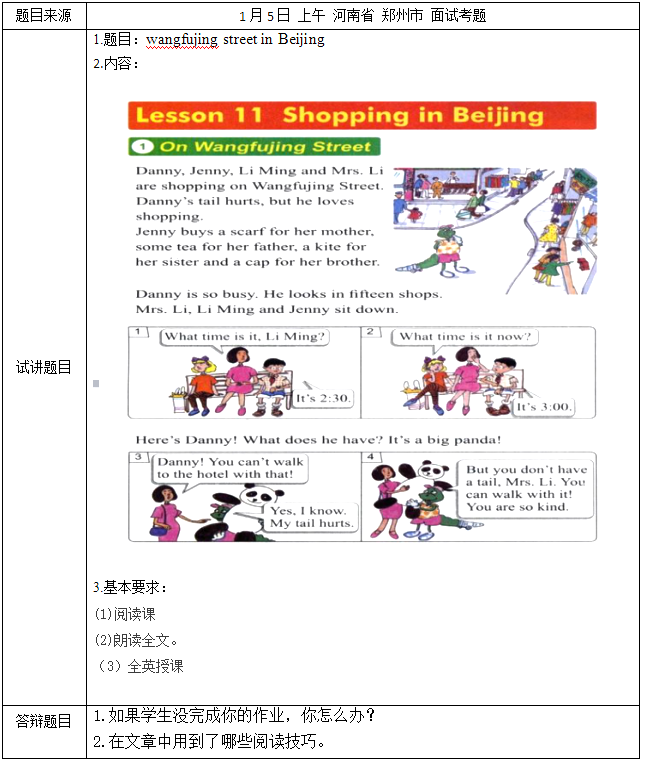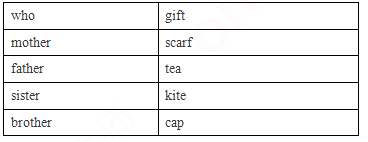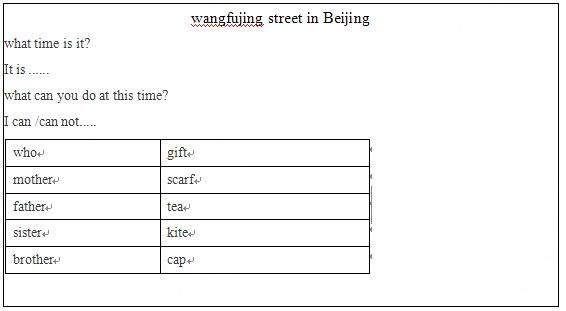小学英语?阅读一、考题回顾二、考题解析【教案】Teaching aims:Knowledge aim:Students can master the sentence :”what time is it? it is ..” and you can/ can not ...”Ability aim:Students can improve their reading skills including scanning and skimming skillsEmotional aim:Students can be more interested in English and take part in activities.Key and difficult point:Key Point: know how to ask about the time and master the sentences::”what time is it? it is ..” and you can/ can not ...”Difficult Point: use the sentence structure in daily life.Teaching procedure:Step 1: Warming-up1. Greetings.2. Ask students how did they spend their weekend.3. Ask students “do you know wangfujing street in Beijing”Step 2: Pre-reading1. show a picture about wangfujing street and ask “what can you see in this picture”2. draw a clock and ask students “Do you know how to ask about time?” and “what can you do at this time?Step 3: While-readingGlobal reading: Ask students :”how many characters in the dialogue?” and “where are they”Detailed reading: what does Jenny buy and who will get the gift?Step4: Post-reading1. Role-play: two students in a group. One student act as traveller and one student is tour guide. Give them 5 minutes to make dialogue with what we have learnt today.Step5: Summary and HomeworkSummary: ask a student to conclude the content of the lesson and summarize with the whole class.Homework: ask students to practice the sentence structure learned today with desk mates after class.Blackboard design:1. What will you do if the students don't finish your homework?2. What reading skills are used in the passage?
小学英语?阅读
一、考题回顾

二、考题解析
【教案】
Teaching aims:
Knowledge aim:
Students can master the sentence :”what time is it? it is ..” and you can/ can not ...”
Ability aim:
Students can improve their reading skills including scanning and skimming skills
Emotional aim:
Students can be more interested in English and take part in activities.
Key and difficult point:
Key Point: know how to ask about the time and master the sentences::”what time is it? it is ..” and you can/ can not ...”
Difficult Point: use the sentence structure in daily life.
Teaching procedure:
Step 1: Warming-up
1. Greetings.
2. Ask students how did they spend their weekend.
3. Ask students “do you know wangfujing street in Beijing”
Step 2: Pre-reading
1. show a picture about wangfujing street and ask “what can you see in this picture”
2. draw a clock and ask students “Do you know how to ask about time?” and “what can you do at this time?
Step 3: While-reading
Global reading: Ask students :”how many characters in the dialogue?” and “where are they”
Detailed reading: what does Jenny buy and who will get the gift?

Step4: Post-reading
1. Role-play: two students in a group. One student act as traveller and one student is tour guide. Give them 5 minutes to make dialogue with what we have learnt today.
Step5: Summary and Homework
Summary: ask a student to conclude the content of the lesson and summarize with the whole class.
Homework: ask students to practice the sentence structure learned today with desk mates after class.
Blackboard design:

1. What will you do if the students don't finish your homework?
2. What reading skills are used in the passage?
一、考题回顾

二、考题解析
【教案】
Teaching aims:
Knowledge aim:
Students can master the sentence :”what time is it? it is ..” and you can/ can not ...”
Ability aim:
Students can improve their reading skills including scanning and skimming skills
Emotional aim:
Students can be more interested in English and take part in activities.
Key and difficult point:
Key Point: know how to ask about the time and master the sentences::”what time is it? it is ..” and you can/ can not ...”
Difficult Point: use the sentence structure in daily life.
Teaching procedure:
Step 1: Warming-up
1. Greetings.
2. Ask students how did they spend their weekend.
3. Ask students “do you know wangfujing street in Beijing”
Step 2: Pre-reading
1. show a picture about wangfujing street and ask “what can you see in this picture”
2. draw a clock and ask students “Do you know how to ask about time?” and “what can you do at this time?
Step 3: While-reading
Global reading: Ask students :”how many characters in the dialogue?” and “where are they”
Detailed reading: what does Jenny buy and who will get the gift?

Step4: Post-reading
1. Role-play: two students in a group. One student act as traveller and one student is tour guide. Give them 5 minutes to make dialogue with what we have learnt today.
Step5: Summary and Homework
Summary: ask a student to conclude the content of the lesson and summarize with the whole class.
Homework: ask students to practice the sentence structure learned today with desk mates after class.
Blackboard design:

1. What will you do if the students don't finish your homework?
2. What reading skills are used in the passage?
参考解析
解析:1.
Homework is an important means to show students' intelligence and improve their quality. Doing homework is the summary and consolidation of the knowledge learned, so doing homework is one of the important means for students to master knowledge.Third, fourth grade students such as not to assign homework is not conducive to the timely review of students to consolidate the knowledge, is not conducive to students to develop good learning habits. Therefore, how to help students homework on time with high quality is the primary task of every teacher.
firstly, I will talk to students to analyze the reason why he did not finish the homework. The reason maybe as follows: He dose not how to do it without any help. or he thinks homework is so much and can not finish it and so on. Then I will take action according to the reasons.
2.
In order to make students be more interested in reading and can understand the knowledge clearly, I use detailed reading to make students find the detail information and global reading to find the how many characters in the dialogue. In the reading passage. students can master and scanning skills and skimming skills. They can understand the passage step by step.
Homework is an important means to show students' intelligence and improve their quality. Doing homework is the summary and consolidation of the knowledge learned, so doing homework is one of the important means for students to master knowledge.Third, fourth grade students such as not to assign homework is not conducive to the timely review of students to consolidate the knowledge, is not conducive to students to develop good learning habits. Therefore, how to help students homework on time with high quality is the primary task of every teacher.
firstly, I will talk to students to analyze the reason why he did not finish the homework. The reason maybe as follows: He dose not how to do it without any help. or he thinks homework is so much and can not finish it and so on. Then I will take action according to the reasons.
2.
In order to make students be more interested in reading and can understand the knowledge clearly, I use detailed reading to make students find the detail information and global reading to find the how many characters in the dialogue. In the reading passage. students can master and scanning skills and skimming skills. They can understand the passage step by step.
相关考题:
Ⅱ.某乡镇中学有100名初一学生,他们先前所在小学均未开设英语。现拟对其进行 一项题为“多媒体教学对初一学生英语阅读成绩影响的研究”的真实验。请问:最好选用哪种实验设计(写出其名称和格式)?为什么?
认真阅读下列材料,并按要求作答。 根据上述材料完成下列任务:(1)简述英语儿歌的特点(2)如指导小学生学习,试拟定教学目标。(3)依据拟定的教学目标,设计导入和操练环节的教学活动并说明理由。
请认真阅读下列材料,并按要求作答。请根据上述材料完成下列任务:(1)简述在小学英语教学中应如何使用多媒体。(2)如指导小学生学习材料,试拟定教学目标。(3)依据拟定的教学目标,设计导入环节和新知呈现环节的教学活动并说明理由。
单选题教幼儿学英语应当从培养幼儿的()能力开始。A英语倾听B英语表述C英语阅读D英语书写